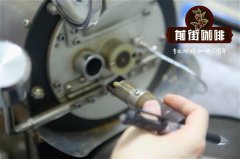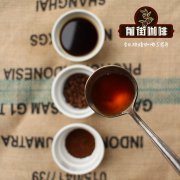Story Flavor characteristics of Gotiti Guti / Guoding Coffee growing area in Yejia Coffee producing area

Professional coffee knowledge exchange more coffee bean information please follow the coffee workshop (Wechat official account cafe_style)
The term 'Yirgacheffe' has been popular in the international coffee market, and it has indeed stolen the limelight over the past decade. Most people generally (or roughly) know that Yegashafi coffee beans are produced in the town of Yegashefi in the Gedeo district of southern Ethiopia, and a similar place name is always followed by a noun such as Wenago, Beloya, Idido. Wait. According to the explanation of professional bean hunters (or professional purchasers) who often travel to and from the producing areas, there are many vague marks, many misplaced positions, and many misinformation.
According to the relevant public information of Linking Coffee, it is necessary to do some work to clarify the relationship between this administrative rank, otherwise even many upstream importers of raw beans will be "confused".
To understand this, Linking Coffee says, you need to understand the four hierarchical structures of Ethiopia's administrative divisions:
Province (Provine)-District (Zone)-Township / Town (Woreda)-Village / Community (Kebele)
According to the official regulations of Ethiopia, the legal production areas of 'Yirgacheffe', which we are familiar with, are distributed in two districts (Zone), with a total of eight townships (Woreda):
Gideo area: Dilla,Wenago,Bule,Yirgacheffe,Kochere,Gedeb
Polina District: Abaya,Gelena
Therefore, the Gedeb beans refer to coffee beans from the town of Gedeb Woreda in Gedeo Zone. Its rank is the same as that of Kochere, and it is not a small village under the town of Cochel, because there is indeed no Jettip Gedeb among the 25 villages under the town of Cochell. (some bean merchants or coffee makers are misplaced occasionally.)
According to Linking Coffee, the misplacement is understandable. After all, Jettip's location is indeed remote, at least 40 kilometers away from the most famous town of Yegashefi, but that is only to reach the town of Jettip.
If you want to go deep into Wauka. Sakaro (Worka Sakaro), Harold. Barretti (Halo Bariti), Banke. Guodintin (Banko Gotiti), Banke-Dahathu (Banko Dahato) … Wait for the village, but also have to walk more than ten kilometers of mud road, it is really not easy to reach.
According to several common categories of Ethiopia currently on the market, the four major producing areas classified by ECX export regulations have been registered in the Ethiopian Farmers' Union (YCFCU) cooperatives from independent processing plants, cooperatives, or smallholder batches in regional villages (KEBELE).
Woka is located in the southernmost Jetipu producing area (GEDEB) of Yega Sheffield. In the early years, the area used the name of Waka to export locally produced coffee beans, or handed over to the Waka Cooperative for processing. But over the past two or three years, one by one "independent"single source" has been excavated by coffee hunters all over the world, such as BANKO GOTITI, BANKO DADHATO, HALO BARITI and so on. Guodingding village is the village area that was first independent a few years ago (BANKO GOTITII became independent from the large Waka cooperative in 2012) many self-employed small farmers were also members of the Woka cooperative. The technology of producing coffee is of course out of the question. At present, there are about 300 farmers, they are very excellent and full of experience and wisdom of farmers! Each person can harvest an average of 1 to 2 hectares of agricultural land, most of which is treated in the traditional way of solarization. The Waka Cooperative is located in a remote area of the Yegashafi producing area, 75km from the local coffee distribution town of DILLA. Originally made up of 305 farmers, the cooperative is a smaller farmers' cooperative with an planting area of about 763 hectares and an annual output of nearly 460 tons. Because no chemical fertilizers or pesticides are used in coffee cultivation, Waka farmers have also obtained the SKAL organic coffee certification recognized by the European Union. These coffees not only have organic and fair trade certification, some even come from coffee trees up to 2300 meters high, such unique local conditions create the unique flavor of these Ethiopian coffee.
The mature coffee cherry fruit is carefully selected during harvest and dried on a high African friend shelf for 2-3 weeks. The temperature of fermentation is carefully controlled to ensure proper air circulation. It is also necessary to rely on experienced farmers to turn the cherry fruit regularly to avoid damage to the flavor of raw beans during drying, followed by the removal of flesh and pods (sheep skin). Do not export until the moisture content is reduced to 11-12% in warehouse storage.
BANKO GOTITI Fruit Ding is treated by the Alim washing plant in the Yirgacheffe area of Ethiopia, and the perimeter is surrounded by Sidamo is a quite special Mill Station. About 700 small coffee farmers in the community each own 2 to 5 hectares of land planted in shade cities, and recently bought Eco-pulper to reduce the waste of water resources.
Guodingding Village is the village area that was first independent a few years ago (Banko Gotitii became independent from the large Waka Cooperative in 2012).
Many self-employed small farmers were also members of the Waka Cooperative at that time.
The technology of producing coffee is of course out of the question.
At present, there are about 300 farmers, they are very excellent and full of experience and wisdom of farmers!
Each person can harvest an average of 1 to 2 hectares of agricultural land.
Most of them are treated in the traditional way of tanning.
The Waka Cooperative is located in a remote area of the Yega Sheffield producing area.
It is 75 kilometers from the town of Dilla, the local coffee distribution center.
At first the cooperative was made up of 305 farmers
The planting area is about 763 hectares.
With an annual output of nearly 460 tons, it belongs to small-scale farmers' cooperatives.
Because no chemical fertilizers and insecticides were used in the coffee planting process.
Wauka farmers have also obtained the Skal organic coffee certification recognized by the European Union.
These coffees not only have organic and fair trade certification
Some coffee even comes from coffee trees up to 2300 meters high.
Such unique local conditions create the unique flavor of these Ethiopian coffee.
Qianjie coffee: Guangzhou bakery, the store is small but a variety of beans, you can find a variety of unknown beans, but also provide online store services. Https://shop104210103.taobao.com
Important Notice :
前街咖啡 FrontStreet Coffee has moved to new addredd:
FrontStreet Coffee Address: 315,Donghua East Road,GuangZhou
Tel:020 38364473
- Prev

Yega Xuefei Coffee production area Chelelektu Coffee planting situation Story Flavor characteristics of the production area
Professional coffee knowledge exchange more coffee bean information Please follow the coffee workshop (Wechat official account cafe_style) Yirgacheffe) there are many washing plants that handle cherries from small coffee farmers nearby, and the coffee is often amazing, like an empty valley orchid in the mountains. Chelelektu is one of them. Xuelitu Water washing Factory is located
- Next

Story Flavor characteristics of Gedeb Jettip / Godibe Coffee growing area in Yega Sheffei Coffee area
For more information on coffee beans, please follow the coffee workshop (official Wechat account cafe_style). The four-class structure of Ethiopia's administrative region is first mentioned: province (Provine)-district (Zone)-township / town (Woreda)-village / community (Kebele), while Yegashafi, as regulated by Ethiopian officials, is distributed in two districts (Zone), with a total of eight townships (
Related
- Detailed explanation of Jadeite planting Land in Panamanian Jadeite Manor introduction to the grading system of Jadeite competitive bidding, Red bid, Green bid and Rose Summer
- Story of Coffee planting in Brenka region of Costa Rica Stonehenge Manor anaerobic heavy honey treatment of flavor mouth
- What's on the barrel of Blue Mountain Coffee beans?
- Can American coffee also pull flowers? How to use hot American style to pull out a good-looking pattern?
- Can you make a cold extract with coffee beans? What is the right proportion for cold-extracted coffee formula?
- Indonesian PWN Gold Mandrine Coffee Origin Features Flavor How to Chong? Mandolin coffee is American.
- A brief introduction to the flavor characteristics of Brazilian yellow bourbon coffee beans
- What is the effect of different water quality on the flavor of cold-extracted coffee? What kind of water is best for brewing coffee?
- Why do you think of Rose Summer whenever you mention Panamanian coffee?
- Introduction to the characteristics of authentic blue mountain coffee bean producing areas? What is the CIB Coffee Authority in Jamaica?

